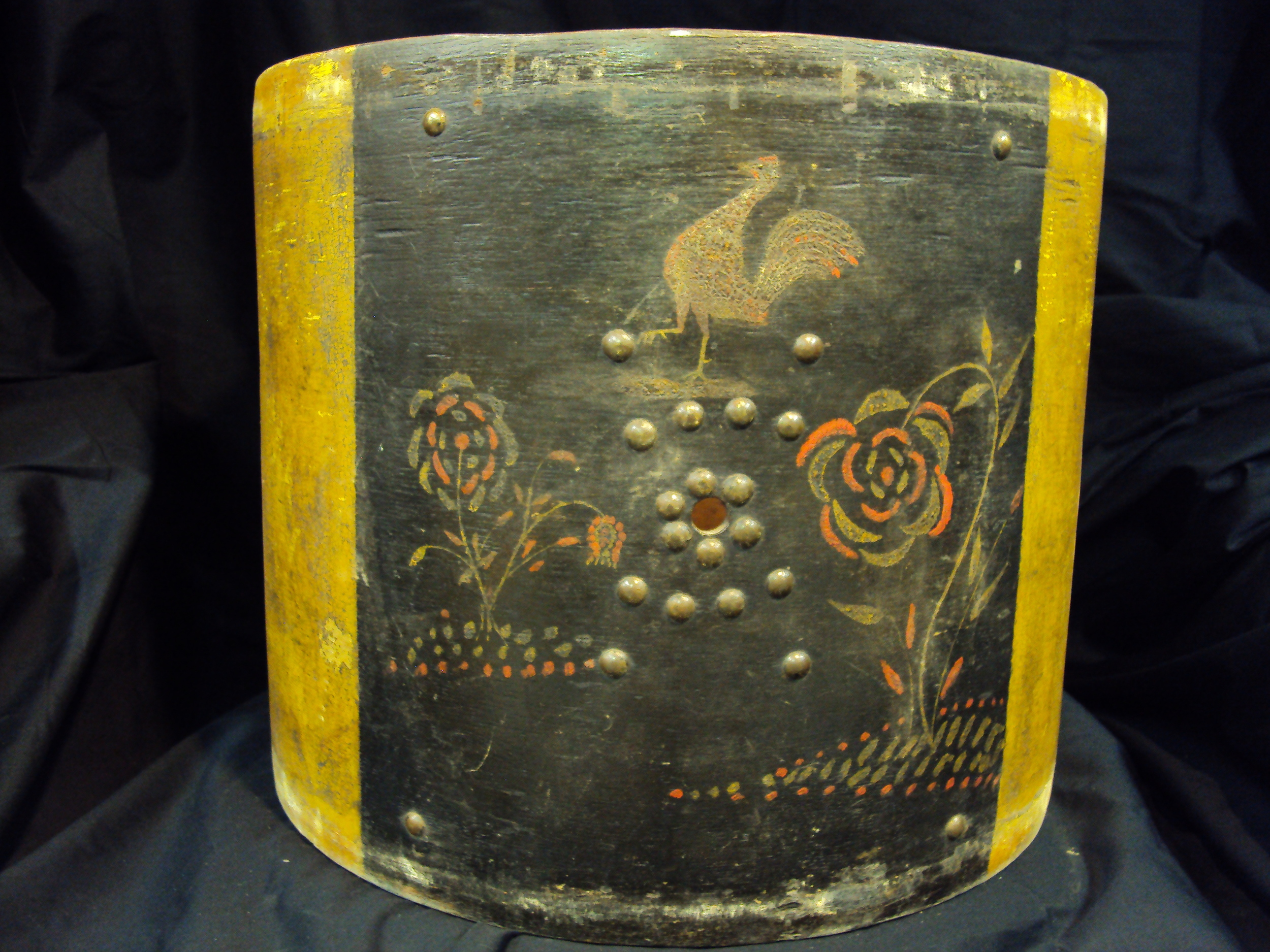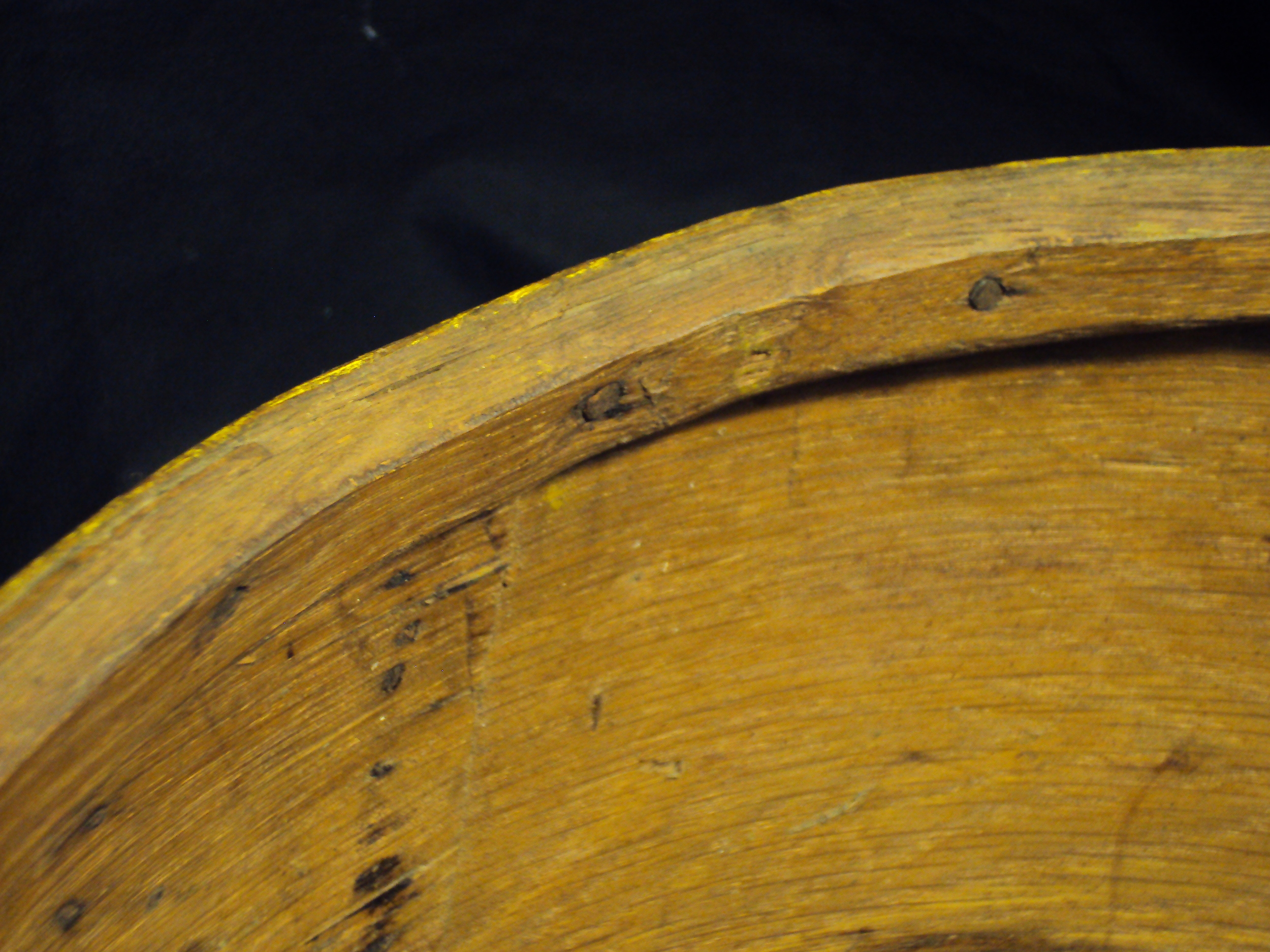Maker: Unknown
Circa: Pre/Early Revolutionary Period
Dimensions: 12.5”(h) x 16”(dia)
The years of the “American Revolutionary Period” are actually comprised of a full half century of turmoil and optimism. It started following the end of the French and Indian War in 1765 as a congress of delegates from nine colonies met in New York to protest the Stamp Act, and ended with the close of the second war with Great Britain in 1815. This period in American history would no doubt be viewed as a formative era as it gave rise to and became a nation with a mixed identity of ultimate union. This era can also be divided into two distinct periods: the years of Revolution and the years of construction. The birth of this drum seems to fall conservatively, somewhere before or early into this fascinating time: the third quarter of the 1700’s.
Completely constructed of thick cut ash, this sturdy relic from the birth period of our American nation is wonderfully preserved, as should be in the case of such an early, historical piece. Formally of a New England estate, this very unique drum must have been recognized for the role it must have played during a very special time in history, and thus carefully protected from the destructiveness of time and abuse. What’s left is an exceedingly playable instrument that’s true to the Period.
The shell is made of a quarter inch of rough cut ash, and joined by a simple scarf (or lap) joint, as are the two counter hoops which measure 1 ¾” high and 5/16” thick. The scarf joint of the shell and hoops are held tightly in place by three vertical rows of closely placed, hand-cut iron nails. It would not be out of place for the maker to have also used a natural animal based glue to help tighten things up for a more solid fit. The scarf joints were hand cut and shaped, aiding in the drums over-all hand-made, rustic appearance. Inside the shell are two small, hand carved glue / reinforcement rings, also held in place by natural glue and hand cut iron nails. There is no maker’s mark or label, nor any writing inside the shell; somewhat obscuring a definitive origin.
Atypical to most conventions of rope drum making as we know, the vent hole is not located in the middle of the scarf joint, but rather a third way around the shell where the drums decorated panel sits. Measuring eleven inches wide and almost thirteen inches high, the decorative panel is solid black, while the remainder of the entire shell is painted in a mustard color. Painting the entire shell was a somewhat common practice of drums from this period. Centering the panel is the unreinforced vent hole, surrounded by a small, unique brass tack pattern that seems more a decorative design than maker’s mark, as would have been more common in a later time.
On each side of the tacking is a hand-painted, folk art rose or flower. While directly above the tacking struts a vividly detailed rooster, all in red and mustard paint. The care and detail of the painting of the rooster is most impressive as well as is the tiny brass nail that was perfectly placed as the eye of the bird. The flowers seem to be of a more common folk-art approach. While the symbolism of the flowers may amount to nothing more than a mere optimistic decoration, the rooster may be a whole other matter.
Rooster symbolism is something that would be very familiar to the people of this era and may mean different things to different people. Of all the meanings researched and uncovered, a few may be more relevant here than others. The first theory that came to mind was the “French connection.” Being a long-time enemy of Britain, many supporters of American independence were in favor of French intervention in the war effort. Long a symbol of France, the French Rooster finds its roots in a time when France was known in Europe as Gaul, a play on the Latin word Gallus, which meant rooster or game cock, dating back to Roman times.
Other and more probable interpretations of this symbolism fall back on the rooster being a long-time associate of the sun, coupled with other lateral and literal meanings. The image of a rooster’s crowing at dawn would symbolically usher in a new day, or era, opportunity, hope, or even a new country. In line with this ideology, and very intriguing, is that of the rooster as a symbol of the Masons and the Knights Templar, as there were many confirmed and suspected Free Masons among the Patriots.
Close observation of the painted bird netted some important clues to consider as to what may be the most accurate interpretation of the theme and time period of the drums origin. First was noticed that the bird had obvious spurs on its legs; the second was the absence of the bird’s wattle and that of a pronounced “comb” on the roosters head. These clues led to the realization that this was a Game Cock. In the Colonies, cock fighting was considered second only to horse racing in sporting America. It crossed all social and political boundaries and provided a boost to many local economies. It was almost on its way to becoming a national sport. The most enthusiastic “cockers” were the people living from New York down to North Carolina, although not exclusively as it was common in all of the Colonies.
When a rooster was bred and trained for the fight ring, each leg was fitted with one or two razor sharp spurs of iron or silver with which the cock bird would slash away at its opponent. The birds also had their combs and wattles removed so their opponent could not latch on to them in a fight. This practice was called being “dubbed.” Matches were continued to the death or when nether bird could no longer fight: a true blood sport. Cock fighting in America reached its zenith somewhere between 1750 and 1800.
However, despite the popularity, public opinion against the sport started to surface in earnest during the early 1750’s. The Continental Congress and several colonies/states had passed laws prohibiting the sport in the 1770’s. By the time of the Revolutionary War, many citizens of the new United States looked upon cock fighting as an “unsavory vestige of English culture and advocated its abandonment.” The attitude of many Americans was to be as “un-English” as possible in those formative years.
Having a proud and possibly controversial game cock on ones drum would portray an image of fierceness and a willingness to fight to the death for ones beliefs. It is also a way to aid in the dating of the relic. Cock fighting in America goes back to the 1600’s, but by the second half of the 1700’s, it was losing social popularity. If this emblem was the pivotal theme weighed in conjunction with the rest of the clues imbedded with the drum, it would have to be interpreted as hailing somewhere around 1750 to possibly as late as 1790. More than likely, the earlier portion of this time period seems to make the most sense.
Restoration of the drum was not out of the norm as it was apparent that the drum had been restored sometime around the turn of the 20th century as indicated by the calf heads, sash rope, and the replacement leather ears present when the drum was acquired. A stout and careful cleaning was greatly needed, along with a modest shinning of the brass tacks and the roosters’ eye, as the drum’s condition reflected years of non-use. Ten new period correct leather ears, cotton rope, gut snares, a leather snare butt and one leather rope washer were all that were needed.
Both of the large black counter hoops were in great shape with the top hoop having an extra hole, presumably used in conjunction with a devise to attach the drum to a drum sling. A hand-made, wrought iron ring was attached here via a black leather lace. The snare and resonant calf skin heads, as well as the flesh hoops were in good shape from the last restoration of over one hundred years ago, so a small bit of love and attention were all that was needed to make it a player.
Since there were no snare beds, gates or evidence of any mechanical snare adjuster present, the snares were anchored with the leather snare butt and simply run between the shell and hoop. Another period way to apply the snares would have been to cut and twist all the snares from the same piece of gut, leaving a “knot” in place of a butt, and running the opposite end through the shell and hoop. Either of these methods for applying snares would have been predominant and very common during this time period, and appropriate for this drum.
Being exceedingly sturdy and comparatively very heavy relevant to drums dated to a later time, it seems to be fairly similar in those respects to other examples of this period of early American drums. The research on this drum invariably fell into several disciplines and needed to fall under the eyes of a seemingly large assortment of museum curators, collectors and experts in antiques, drum history, folk-art, fraktur, as well as general history. The over-all consensus and opinion, based on the construction style and type, materials, folk-art décor, not to mention over-all feel, was that this drum was indeed from the period prior to or during the early Revolutionary Period of American history: the third quarter of the 18th Century.
The exact meaning of the symbolism or whether or not this drum was used in an important battle is somewhat unclear. The style of and scars visible upon this relic surely testify that it was indeed used hard in some respect as a military instrument. The placement of any symbol on an object as important as a drum would have to be thought out carefully, so the presence of the Game Cock at the top center of this drum has to be significant to the cause. As now, Colonial Americas loved the sports of the day. They literally bet on everything from horse racing, dog fights, rat fights and of course cock fights, to name a few. People from every class owned, fought and bet on game cocks. Despite all the polite bows, satin lace and high rhetoric that laid thick on the surface, laid below a strong desire and lust for the blood sports of the day.
From Lancaster County PA…..…Thoughts from the Shop.










